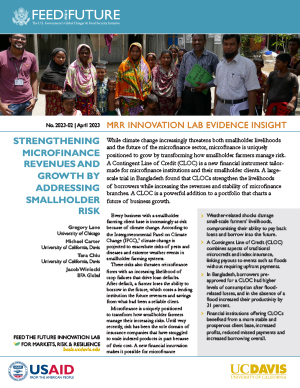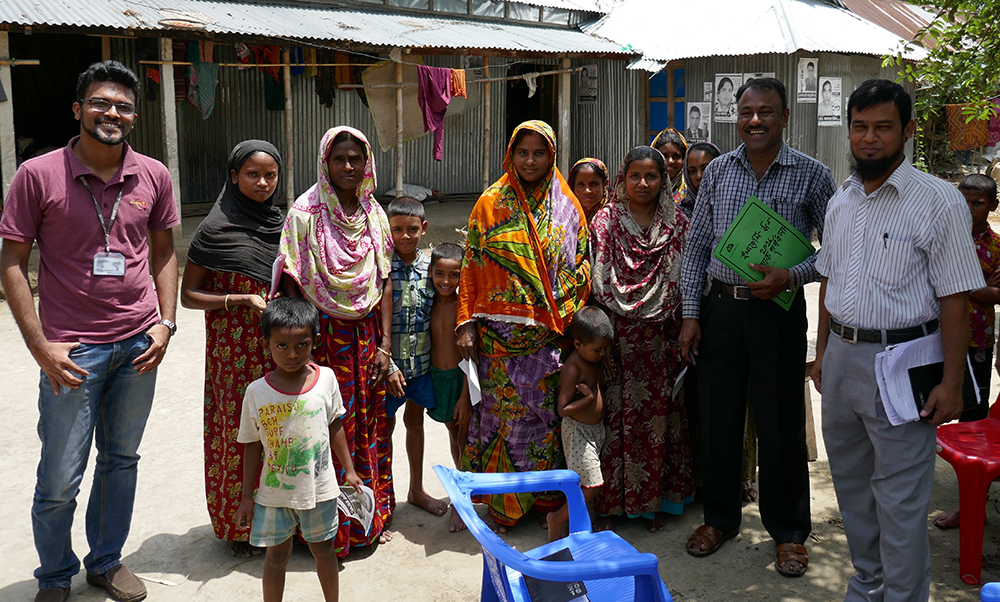While climate change increasingly threatens both smallholder livelihoods and the future of the microfinance sector, microfinance is uniquely positioned to grow by transforming how smallholder farmers manage risk. A Contingent Line of Credit (CLOC) is a new financial instrument tailor-made for microfinance institutions and their smallholder clients. A large-scale trial in Bangladesh found that CLOCs strengthen the livelihoods of borrowers while increasing the revenues and stability of microfinance branches. A CLOC is a powerful addition to a portfolio that charts a future of business growth.
Highlights
- Weather-related shocks damage small-scale farmers’ livelihoods, compromising their ability to pay back loans and borrow into the future.
- A Contingent Line of Credit (CLOC) combines aspects of traditional microcredit and index insurance, linking payouts to events such as floods without requiring upfront payments.
- In Bangladesh, borrowers pre-approved for a CLOC had higher levels of consumption after flood-related losses, and in the absence of a flood increased their productivity by 31 percent.
- Financial institutions offering CLOCs benefited from a more stable and prosperous client base, increased profits, reduced missed payments and increased borrowing overall.
Every business with a smallholder farming client base is increasingly at risk because of climate change. According to the Intergovernmental Panel on Climate Change (IPCC),[1] climate change is projected to exacerbate risks of pests and diseases and extreme weather events in smallholder farming systems.
These risks also threaten microfinance firms with an increasing likelihood of crop failures that drive loan defaults. After default, a farmer loses the ability to borrow in the future, which costs a lending institution the future revenues and savings from what had been a reliable client.
Microfinance is uniquely positioned to transform how smallholder farmers manage their increasing risks. Until very recently, risk has been the sole domain of insurance companies that have struggled to scale indexed products in part because of their cost. A new financial innovation makes it possible for microfinance institutions to provide clients similar risk coverage at no up-front cost. In a large-scale field trial in Bangladesh, this product improved borrowers’ livelihoods as well as their lenders’ bottom line.
Leveraging Credit to Manage Risk
A Contingent Line of Credit (CLOC) is a new type of indexed loan that releases funds to a pre-approved borrower in the event of a disaster. This kind of loan is similar to index insurance in that both are based on a pre-determined index of factors related to a disaster, such as rainfall or flood levels, that predict agricultural losses. The main difference for a borrower is that, unlike insurance, there is no up-front cost.
A recent large-scale randomized field trial in Bangladesh[2] pioneered a CLOC product in partnership BRAC Microfinance, one of the world’s largest microfinance institutions. In that study, 60,000 borrowers with a long history of repayments were pre-approved for a CLOC valued at up to half of the amount of their last approved loan. The pre-approval was timed so clients could adjust their investments in planting with confidence that some risk could be covered.
The BRAC CLOC generated two key benefits for borrowers, as discussed in a 2022 MRR Innovation Lab Evidence Insight.[3] After a flood disaster, clients who were pre-approved had 9 percent higher levels of consumption compared to clients who were not pre-approved. Also, CLOC pre-approval itself increased investments in productivity that grew crop production by 31 percent compared to clients not given access to the CLOC loan.
Direct Benefits for Lenders

In addition to benefits for borrowers, a CLOC benefits lending institution branches. In Bangladesh, BRAC branches that offered the CLOC had a 4-percent increase in per-person net revenue compared to branches that did not. The largest increase came from clients with credit scores near the cutoff who had the highest improvements in repayments among those pre-approved.
CLOC pre-approval also kept savings intact. There was a 4-percent decrease overall in missed payments in BRAC branches that offered the CLOC compared to branches that did not. The CLOC also reduced withdrawals from savings accounts after a flood disaster.
The CLOC also increased overall borrowing. BRAC clients pre-approved for the CLOC were 11 percent more likely to take a conventional loan. This shows that the increases in farm production when a CLOC is available can increase overall demand for financial services.
Meeting Client Demand
One way to think about a CLOC is as transitional financing. After a disaster, a CLOC makes it possible for a borrower to refinance an existing loan and to start over in the next season. This bridge financing can play a critical role in regions where a single disaster can force a borrower into default. In areas where smallholder farmers face a high level of weather-related risk, a CLOC can keep a client base secure and able to grow their assets, income and savings.
For lending institutions, a CLOC can be part of a dynamic portfolio of financial tools that support a rural household across their lifetimes. A CLOC can expand a financial institution’s client base for complementary products like insurance that manage weather-related risks.
For clients who cannot afford the up-front cost of insurance, pre-approval for a CLOC can provide support in times of extreme need while enabling investments that increase farm productivity. Further, as borrowers continue to prosper, they may purchase insurance for additional protection. Also, as a client’s income grows, so will their savings.
There is also evidence of significant demand for a CLOC product. When a smaller number of eligible borrowers was offered a limited-time traditional loan of the same amount that would end access to the CLOC, those borrowers were 25 percent less likely to take the traditional loan compared to borrowers who didn’t face such a trade-off. The promise of providing funds in a time of extreme need was of more value than a conventional production loan.
A CLOC could chart a different future for borrowers and the institutions that serve them. The alternative is a dwindling client base who have no means to repay their loans. With the effects of climate change, there is more urgency than ever to scale this proven means to secure the financial foundation of prosperity for all.
[1] Barioni, L.G., et al. 2019. “Food Security.” Special Report on Climate Change and Land. IPCC.
[2] Lane, G. 2022. “Adapting to Floods with Guaranteed Credit: Evidence from Bangladesh.” Working Paper.
[3] Lane, G. 2022. “A New Type of Indexed Loan to Address Risk and Build Beyond Resilience.” MRR Innovation Lab Evidence Insight.
This report is made possible by the generous support of the American people through the United States Agency for International Development (USAID) cooperative agreement 7200AA19LE00004. The contents are the responsibility of the Feed the Future Innovation Lab for Markets, Risk and Resilience and do not necessarily reflect the views of USAID or the United States Government.

